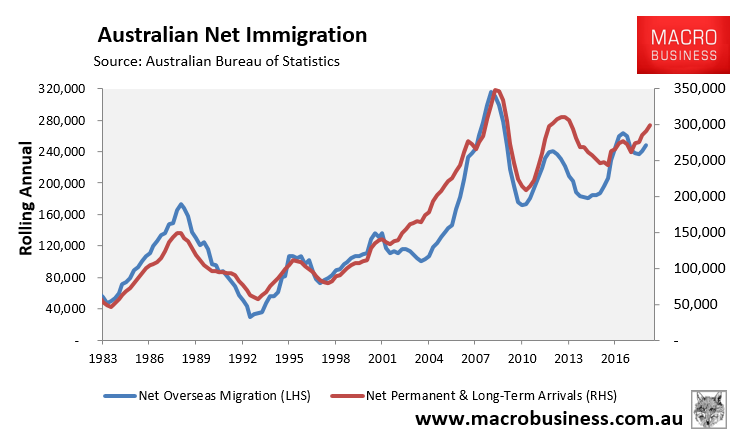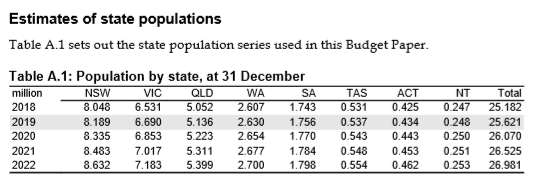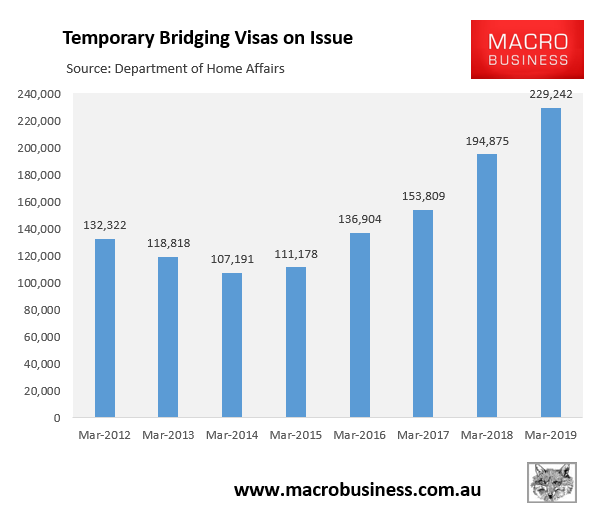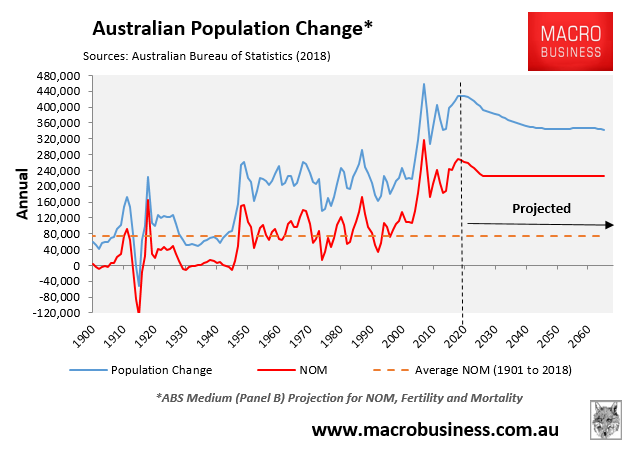Last year, the Morrison Government announced that it would cut Australia’s non-humanitarian permanent migrant intake by 20,000 to 160,000, in order to “relieve congestion in the cities”.
From the outset, MB labelled this a ‘fake cut’, based on the fact that both temporary migration and net overseas migration (NOM) continues to increase, as illustrated in the next chart:

The dishonesty of this immigration cut was further revealed in the April Federal Budget, which projected rising NOM over the forward estimates, as illustrated in the next table:

In a similar vein, the Federal Budget projected massive population increases of around 600,000 (NSW) and 650,000 (VIC) over the forward estimates, with the lion’s share of this growth to go to Sydney and Melbourne:

Therefore, the Morrison Government’s own projections are for immigration to increase and for congestion to get much worse in the cities.
One of the reasons why NOM has continued to rise in the face of lower permanent migration is because the Morrison Government has shunted migrants onto bridging visas, which are given to those awaiting decisions on their applications for permanent residency.
As shown in the next chart, the number of bridging visas on issue has ballooned from 107,000 in March 2014 to 230,000 as at March 2019 – an increase of 123,000:

Indeed, researchers from ANU and Western Sydney University this week questioned the Coalition’s fake immigration cut via bridging visas:
As of March 31, there were 229,242 people in Australia who held a bridging visa, the highest-ever figure in Australian history. A significant portion of bridging visa applicants are skilled and family migrants, often partners of Australian permanent residents and citizens…
They meet all the legal criteria for migration and are simply waiting for their applications to be processed by the Department of Home Affairs. For example, while there were 28,000 applicants for onshore asylum visas in 2017-18, there were more than 125,000 people holding a bridging visa and waiting for their permanent visa application to be finalised…
Perhaps the primary reason for the so-called “blowout” in bridging visas – as quoted in an ABC article – is simply because more legitimate applications for skilled and family migration are now made in Australia and waiting times for visa processing have increased.
Compare permanent partner visas in 2009-10 and 2017-18. There were about 53,000 applicants for partner visas in 2009-10. And there were 27,000 people waiting in the queue in June 2010.
Eight years later, there were 54,000 applicants for partner visas, but with fewer places available (39,800) and more than 80,000 people waiting in the queue…
A consequence of under-resourcing in the Department of Home Affairs is that the time migrants spend living on bridging visas is increasing as the time taken to process a visa application grows.
Jonathan Granger, director of Granger Australia and a former national president of the Migration Institute of Australia, has described the migration program as “chaotic”, as evidenced by the blow-out in bridging visas:
“The resources available to the department are limited every year by Government, and yet Government rolls out reform agendas that are not well thought through, that require transitional arrangements and require multiple layers of processing against regulations in the same visa areas,” he said.
“The result of those things is significant delays”..
Mr Granger said the program changes and lack of resources meant there were growing numbers of visa refusals that ended up at the Administrative Appeals Tribunal.
The most “chaotic” thing about Australia’s immigration system is not bridging visas, but its sheer size, which is running at roughly triple the historical average:

This is unambiguously creating all manner of problems from chronic infrastructure bottlenecks, to more expensive (and lower quality) housing, environmental degradation, and crushed wages growth.
Instead of manipulating the migration figures with transitional bridging visas, the Morrison Government needs to follow the wishes of the electorate and halve the intake back to historical levels.

